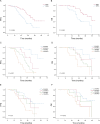Cytogenetic risk stratification combined with minimal residual disease status influences the therapeutic outcome and prognosis of multiple myelomas
- PMID: 40217083
- PMCID: PMC11992232
- DOI: 10.1038/s41598-025-97125-w
Cytogenetic risk stratification combined with minimal residual disease status influences the therapeutic outcome and prognosis of multiple myelomas
Abstract
To explore the value of cytogenetic risk stratification combined with minimal residual disease (MRD) status in predicting the therapeutic efficacy and prognosis for multiple myeloma (MM). From January 2017 to December 2023, 73 cases of newly diagnosed MM were recruited. Cytogenetic risks were stratified according to the results of fluorescence in situ hybridization (FISH); MRD status and clinical data were analyzed. The progression-free survival (PFS) and overall survival (OS), and their influencing factors were evaluated. During the median follow-up period of 30 (4-65) months, the median progression-free survival (PFS) and overall survival (OS) were 38 (95% CI 29.7, 46.3) months and 55 (95% CI 45.9, 64.1) months, respectively. In our cohort, the 3-year PFS rate was 51.0% and the 3-year OS rate was 71.0%. According to the MRD status, 31 MM patients were assigned to the MRD-positivity group and 42 to the MRD-negativity group. Significant differences were detected in the median PFS (30 months vs. 45 months, χ2 = 7.747, P = 0.005) and OS (34 months vs. 59 months, χ2 = 8.683, P = 0.003) between groups. Subgroup analyses based on the cytogenetic risk stratification (standard risk [SR] and high risk [HR]) showed that MM patients in the SR/MRD-negativity subgroup did not reach the median PFS and OS, and the median PFS (42 months vs. 33 months, P = 0.093) and OS (59 months vs. 42 months, P = 0.703) were similar between the SR/MRD-positivity and HR/MRD-negativity subgroups. In comparison to the HR/MRD-negativity subgroup, the median PFS (20 months vs. 33 months, P = 0.031) and OS (33 months vs. 42 months, P = 0.032) were significantly shorter in the HR/MRD-positivity group. Multivariate analysis showed that MRD-positivity was an independent risk factor for PFS (HR 2.874, 95% CI 1.452, 5.689; P = 0.008) and OS (HR 3.504, 95% CI 1.599, 7.676; P = 0.002) of MM. MRD status is a powerful prognostic indicator of PFS and OS in MM, but its performance is inferior to cytogenetic risk stratification. More high-risk cytogenetic abnormalities (HRCAs) indicate a worse prognosis of MM, while MRD-negativity improves HRCA-associated prognosis of MM. We recommend a risk stratification by assessing MRD status combined with HRCAs in MM patients, thus favoring the design of individualized treatment.
Keywords: FISH; High-risk cytogenetics; Minimal residual disease; Multiple myeloma; Prognostic factor.
© 2025. The Author(s).
Conflict of interest statement
Declarations. Competing interests: The authors declare no competing interests. Ethical approval: The study was approved by the Ethics Committee of the First People’s Hospital of Lianyungang (No. KY-20240110001-02), and informed consent was obtained prior to the experiment.
Figures



Similar articles
-
[The prognostic significance of dynamic monitoring of minimal residual disease (MRD) status in patients with newly-diagnosed multiple myeloma].Zhonghua Xue Ye Xue Za Zhi. 2019 Jul 14;40(7):584-588. doi: 10.3760/cma.j.issn.0253-2727.2019.07.009. Zhonghua Xue Ye Xue Za Zhi. 2019. PMID: 32397022 Free PMC article. Chinese.
-
Achieving minimal residual disease-negative by multiparameter flow cytometry may ameliorate a poor prognosis in MM patients with high-risk cytogenetics: a retrospective single-center analysis.Ann Hematol. 2019 May;98(5):1185-1195. doi: 10.1007/s00277-019-03609-x. Epub 2019 Feb 5. Ann Hematol. 2019. PMID: 30721336 Clinical Trial.
-
Impact of Post-Transplant Response and Minimal Residual Disease on Survival in Myeloma with High-Risk Cytogenetics.Biol Blood Marrow Transplant. 2017 Apr;23(4):598-605. doi: 10.1016/j.bbmt.2017.01.076. Epub 2017 Jan 20. Biol Blood Marrow Transplant. 2017. PMID: 28115277
-
A large meta-analysis establishes the role of MRD negativity in long-term survival outcomes in patients with multiple myeloma.Blood Adv. 2020 Dec 8;4(23):5988-5999. doi: 10.1182/bloodadvances.2020002827. Blood Adv. 2020. PMID: 33284948 Free PMC article.
-
Minimal residual disease in multiple myeloma.Presse Med. 2025 Mar;54(1):104261. doi: 10.1016/j.lpm.2024.104261. Epub 2024 Dec 9. Presse Med. 2025. PMID: 39662763 Review.
References
-
- Mohty, M., Avet-Loiseau, H., Malard, F. & Harousseau, J. L. Potential future direction of measurable residual disease evaluation in multiple myeloma. Blood142, 1509–1517. 10.1182/blood.2023020284 (2023). - PubMed
-
- Malard, F. et al. Multiple myeloma. Nat. Rev. Dis. Primers. 1010.1038/s41572-024-00529-7 (2024). - PubMed
-
- Cowan, A. J. et al. Diagnosis and management of multiple myeloma: A review. JAMA327, 464–477. 10.1001/jama.2022.0003 (2022). - PubMed
-
- Zamagni, E., Barbato, S. & Cavo, M. How I treat high-risk multiple myeloma. Blood139, 2889–2903. 10.1182/blood.2020008733 (2022). - PubMed
MeSH terms
Grants and funding
LinkOut - more resources
Full Text Sources
Medical
Research Materials

